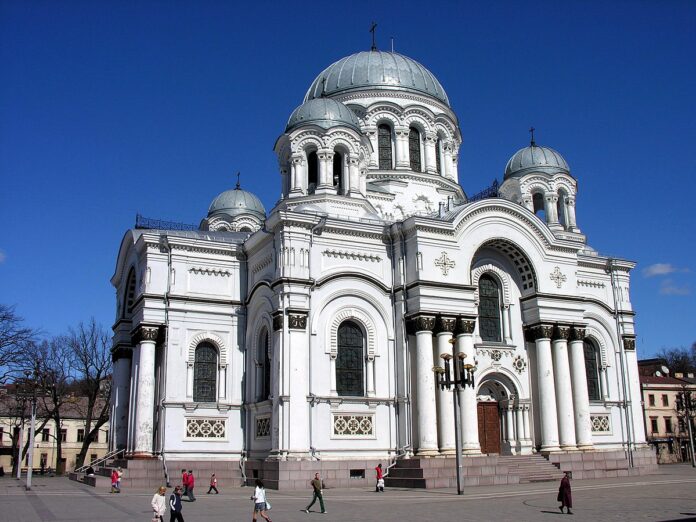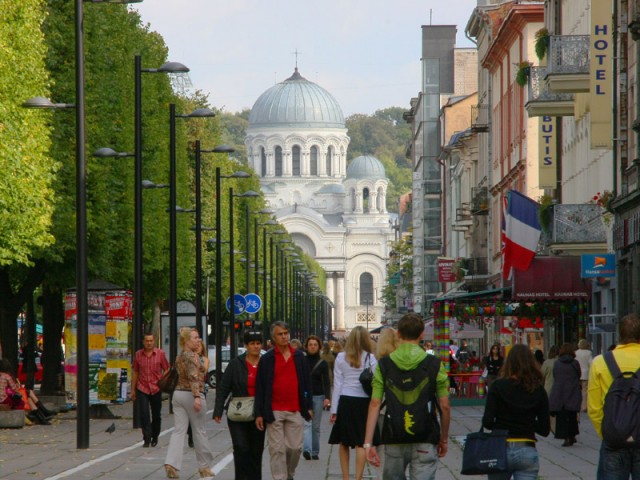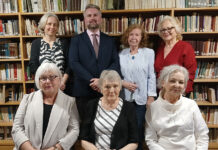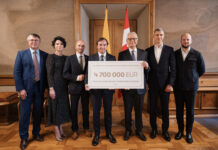
St. Michael the Archangel Church
As you walk east along the famous Laisvės alėja (avenue) in Kaunas, the longest pedestrian street in Eastern Europe, this church, known simply as the Sobor (Soboras), looms impressively in the distance. It was once almost demolished for looking too Russian. This year marks the 30th anniversary of the first mass held in St Michael the Archangel (Garrison) Church after the restoration of Lithuania’s independence. The church has been used by several different religions, but it has probably always been dedicated to the needs of the military. Today it mostly serves the needs of soldiers and statutory officers in Kaunas.
It was built at the end of the 19th century as an Orthodox cathedral – sobor. The architect and the executor of the construction work was a military engineer, Lieutenant Colonel Konstantin Limarenko. Simonas Jazavita, a historian at the Kaunas City Museum, says that when the Sobor was built, the site was on the outskirts of Kaunas, surrounded by swamps. According to some stories, Kaunas residents would come here to hunt for ducks. At the end of the 19th century, the swamp was drained and, with the approval of Tsar Alexander III, a house of worship for the army began to be built on the empty but strategically important site.
The number of Orthodox Christians in Kaunas was small, but as the city became a military stronghold, preparing for a possible war with Germany, the numbers changed. A large number of soldiers arrived, and they were Orthodox Christians.
In 1915, during the First World War, Kaunas was occupied by the Germans and the Sobor was handed over to German troops. Four years later, in 1919, when Lithuania gained independence and the Germans left, it became a Catholic church and was handed over to the Lithuanian military.
It had to be remodelled from an evangelical church. The exterior was unusual – it was a Catholic church, but resembled a Russian Orthodox house of prayer. “This is the uniqueness of our Sobor,” explains Jazavita. There soon arose the question of what to do with the church at the end of Laisvės Avenue. Two options were proposed.
One was to demolish it completely. Jonas Vileišis, a long-time mayor of Kaunas, proposed to tear down the cathedral as an ulcer of Russian imperialism in the middle of the capital. However, Vileišis was quite democratic, and as mayor, did not vote. The prevailing position in the council was to preserve it. The Sobor was then converted into a Catholic church and handed over to the military.
When Lithuania was occupied by the Soviet Union in 1940, there was a campaign to close down houses of worship of all religions. After the war, the Sobor was not immediately decommissioned, but it had to operate under some restrictions.

According to Jazavita, the Sobor was affected by a subsequent wave of anti-religious fervour of 1962. It was handed over to the Čiurlionis Art Museum, which installed a stained glass gallery in it. The people who worked there tried to preserve the unique inter-war frescoes and other important religious and patriotic symbols, of which there were many, painting them over so they would not be damaged. The cross was also removed. In 1991, when the church was handed back to the faithful, much of it was restored.
In July 1991, then Prime Minister Gediminas Vagnorius returned the Church of St Michael the Archangel to the Kaunas Archdiocese. In November of the same year, it was taken over by the chancellor of the Archdiocese, Alfonsas Bulota, who ordered the demolition of the partitions of the museum. In 1996, Cardinal Sigitas Tamkevičius dedicated the Kaunas Sobor to the Kaunas garrison of the Lithuanian Military. Kaunas Garrison Chaplain, Maj. Tomas Karklys says today the church serves not only the military. “Over the years, we have made the church a pastoral base for the Kaunas region’s statutory structures, where soldiers, officers and civil servants alike find solace and pastoral services,” he says. According to Karklys, about 50 marriages and 100 baptisms are held there every season.
The Sobor also hosts a lot of lay activities: educational programmes, an installation for the blind that has attracted a lot of attention, exhibitions and concerts. Nevertheless, it is still called the Sobor, which refers to its former function as an Orthodox cathedral. Karklys notes that “You cannot change the architecture of the building, which is neo-Byzantine, oriental, in style. Its plan is that of a Greek cross. “It is certainly not a crime or an insult to call it the ‘Sobor’, because it was built as a sobor, even though now it serves as a Catholic church,” said Karklys.



























